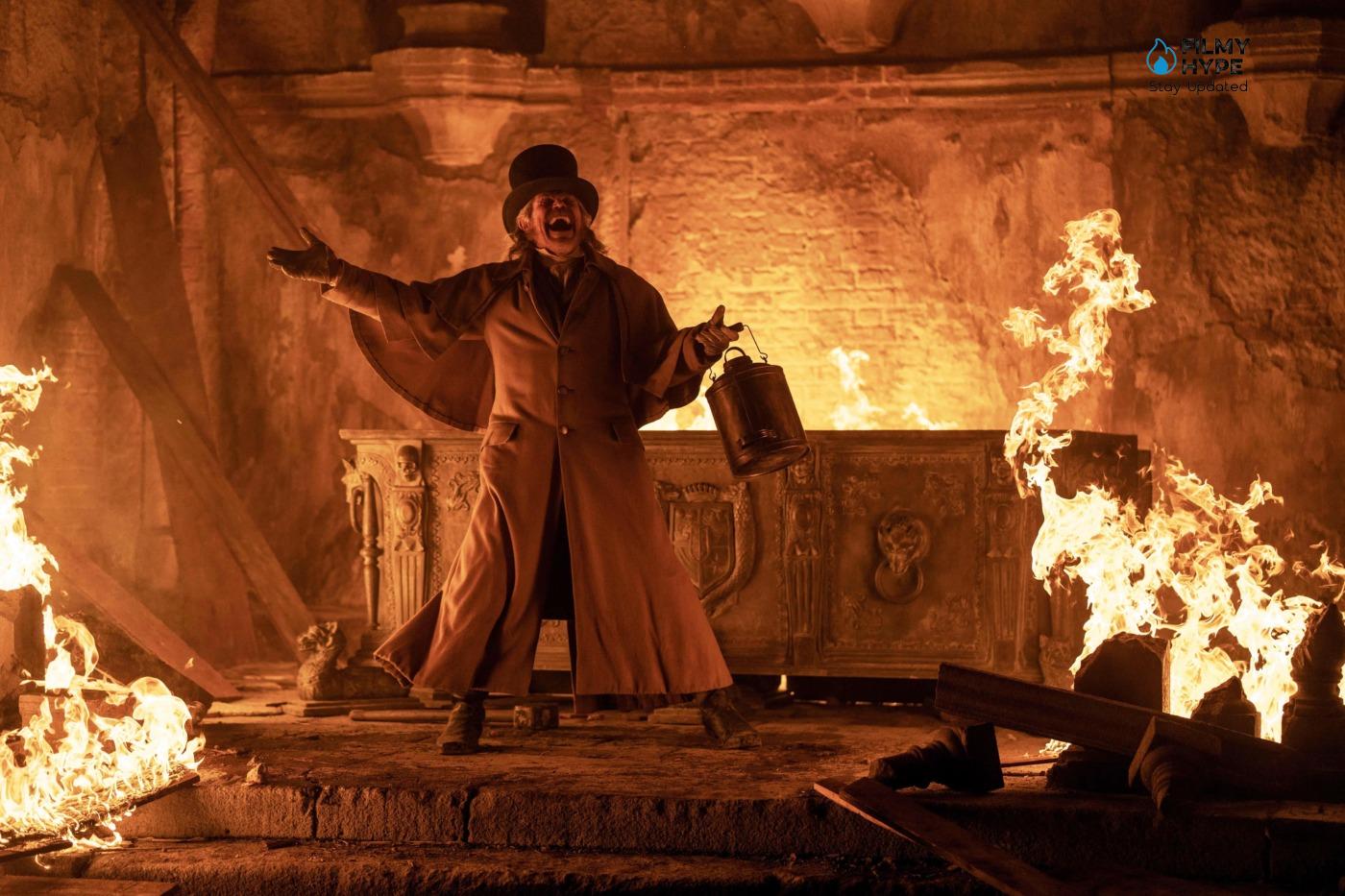Nosferatu Ending Explained: How Does Ellen Defeat Count Orlok?
Nosferatu marks a possible turning point in the career of Robert Eggers, an author with a distinctive set of recurring themes and motifs that make him immediately recognizable to those who frequent his cinema. Still, up to now little is known to the general public precisely for the originality of his vision and the stories he tells. In other words, he is much loved by those few who have given his films a chance, sometimes ignored because they cannot be traced back to well-known characters and franchises. As much as we like to complain about how today’s cinema lacks originality and always proposes the same stories, Eggers will leap to the mainstream with a film that tells a story present in the cinema from the dawn of ninth art: that of the vampire Nosferatu, one of the forerunners of the genus.

“Nosferatu” (2024), directed by Robert Eggers, is a reinterpretation of the 1922 horror classic. The film follows Ellen (Lily-Rose Depp), a young woman caught in a dark bond with the vampire Nosferatu, Count Orlok. Through her past relationship and the recurring nightmares that haunt her, Ellen discovers that to free herself from the monster that consumes her, she must face him and use her own body as a weapon. Eggers delves into Ellen’s psychological nuances, giving her agency and humanity that were not present in the original version. In this remake, Ellen is not just a passive victim, but a woman who decides to face her past and find redemption on her terms.
Nosferatu Ending Explained: How Does Ellen Defeat Count Orlok?
At the climax of the film, Ellen understands that the only way to defeat Count Orlok is to voluntarily relive her relationship with him. This is not an act of submission, but a conscious decision to use your body and your past connection to attract it to its end. Ellen tricks the vampire into believing that she has accepted his influence again, guiding him into an intimate encounter in which he seems to succumb to his wishes.
However, while Orlok drinks from her, Ellen keeps him in the light of dawn. As the sun’s rays consume her, she holds her position firmly, even as she feels her life fade away. In a moment of personal triumph, Ellen looks at the Count as he disintegrates, proving that he has not only defeated the monster but has claimed his own story. Finally, her husband Thomas (Nicholas Hoult) arrives too late, finding her in her last moments of life, with an expression of victory and peace.

What Differentiates this Version of Nosferatu From the Original?
Nosferatu’s 2024 version gives Ellen emotional depth and agency that did not exist in the 1922 film. In the original classic, Ellen was a woman defined solely by her sacrifice to save her husband, where she presents herself as a complex protagonist. His sacrifice is not for the love of Thomas, but a way to redeem himself and overcome the trauma of his past relationship with Nosferatu. Eggers also introduces supporting female characters, such as Anna (Emma Corrin) and the nuns who help Thomas, who reinforce the issue of strength and solidarity among women. These figures complement Ellen’s narrative, showing a world where women face their destinies with courage and determination.
The Symbolism Of The Relationship Between Ellen And Nosferatu
The relationship between Ellen and Nosferatu is addressed as an allegory of abuse, manipulation, and control. Presented as an obsessive stalker, Orlok depicts the ghosts of Ellen’s past that continue to haunt her. His decision to confront him is not an acceptance of his power, but an act of defiance. By using her vulnerability as a trap, Ellen not only destroys the vampire but also frees herself from the guilt and pain she carries.
Ellen’s Sacrifice: An Act of Courage and Redemption?
In the climax of Nosferatu, Ellen Hutter sacrifices herself to stop Orlok and break the curse hanging over the city of Wisborg. After attracting Orlok to his room, Ellen indulges in him, distracting him while Thomas, Dr. Sievers, and Professor Von Franz destroy his coffin. At dawn, the sun hits Orlok, who dies slowly between spasms and blood dripping from his eyes and mouth. Ellen, now bled, dies shortly after, in the arms of her husband Thomas. This scene represents Ellen as the definitive heroine of the story. Unlike previous versions, Ellen’s sacrifice is not the result of angelic purity, but an awareness of one’s role in liberation from evil. Ellen had made a dark pact in the past, awakening Orlok in his solitude. Now, however, he takes control of his darkness and uses it for a bigger end. His sacrifice is not only an act of courage, but also of redemption for inadvertently unleashing evil.
“Death and the Girl”: The Aesthetics of the Ending
One of the most powerful visual elements of the Nosferatu finale is the representation of the symbolic theme of “Death and the girl”. This ancient Renaissance motif portrays a young woman visited by Death, often depicted as a skeletal figure hanging over her. In the film, this image takes shape in the last frame: Orlok, now a corpse, lies above Ellen’s lifeless body. This representation is not only macabre but also strangely intimate and romantic. Orlok represents Death, Ellen the Maiden, but there is also a visceral and twisted bond between the two. Orlok is not only a monster, but also a tragic figure, consumed by his dark nature. Ellen, on the other hand, is not a simple victim, but a complex figure, suspended between darkness and light. This duality makes Eggers’ ending extraordinarily powerful, combining horror and romance in one disturbing image.
Light and Darkness
Unlike previous versions of the myth of Nosferatu, Ellen in this version is not simply a pure and spotless figure. From the outset, it is suggested that Ellen has a particular connection with the dark forces. During a conversation with Orlok, he claims that her nature is intrinsically obscure, something she cannot deny either. Ellen herself admits that she called darkness in the past, driven by despair and loneliness. This inner conflict between light and darkness is the beating heart of the film. Ellen represents humanity in its most complex form: capable of both great heroic actions and falls into the deepest abysses. Her final sacrifice is not only an altruistic act, but also a way to redeem herself and reconcile with her past. Robert Eggers, through this character, explores the dual nature of the human soul, showing how even darkness can be transformed into light through will and sacrifice.
Love as a Common Thread: Between Orlok and Thomas
One of the most fascinating aspects of the Nosferatu finale is the way the theme of love is explored. On the one hand, there is pure and sincere love between Ellen and Thomas, which represents light and hope. On the other hand, there is a dark bond between Ellen and Orlok, which goes beyond simple physical attraction. Orlok sees in Ellen something unique, a sort of dark affinity that binds them inextricably. This dynamic makes the ending not only tragic but also extraordinarily intimate. Ellen chooses Thomas, chooses pure love, but must first confront his connection with Orlok. This symbolic triangle represents the different facets of love: the bright and salvific one, and the dark and destructive one. Eggers thus manages to transform a Gothic horror into a poignant love story.
Robert Eggers’ Words on the Ending
Director Robert Eggers said in an interview that the Nosferatu ending was designed to arouse contrasting emotions: fear, and sadness, but also a sense of beauty and intimacy. The choice to recall the motif of “Death and the girl” is not accidental but is an integral part of the message of the film. Eggers also stressed that the relationship between Ellen and Orlok is fundamental to understanding the meaning of the story. Orlok is not only a villain, but a tragic figure, while Ellen is the heroine who has to pay the price of her darkness. This balance between terror and poetry is what makes Nosferatu’s ending so memorable.
The Legacy of an Unforgettable Ending
Robert Eggers’ Nosferatu ending is not just a shocking or visually impressive moment, but it is the culmination of a story that explores universal themes such as sacrifice, love, and the struggle between light and darkness. Ellen is not a victim, but a complex and powerful heroine who accepts your destiny to redeem yourself and save the world. Eggers has created not only a horror film but a Gothic work of art that will continue to be studied, discussed, and admired in the years to come. Nosferatu is not just a monster, and Ellen is not just a victim: they are eternal symbols of a struggle that belongs to all of us.
Conclusion of Nosferatu
Robert Eggers’ reinterpretation of Nosferatu transforms a classic horror story into a reflection on consent, autonomy, and redemption. Ellen is not a passive victim; she is a heroine who takes charge of her destiny and bravely faces her past. The outcome, while tragic, is a reminder that even in the deepest darkness, there is room for acts of resistance and personal empowerment.



